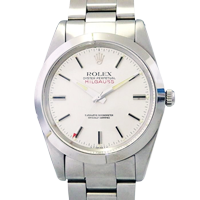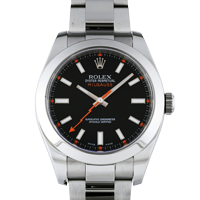Explanation of the history and chronology of MILGAUSS products
We would like to explain the history and chronology of MILGAUSS products. We will explain the products in an easy-to-understand manner even for first-time users.
Milgauss chronology
| 1908 | The brand name "ROLEX" was registered as a trademark in La Chaux-de-Fonds and the manufacture of watches began. |
|---|---|
| 1926 | Start using the Crown trademark. Acquired Oyster, the company that developed the Oyster case, and applied for a patent on its waterproof technology. |
| 1927 | Obtained patent for screw-in crown |
| 1945 | Obtained a patent for the Datejust mechanism. Launch of Datejust and Date. |
| 1956 | The first generation Milgauss Ref.6541 is released. |
| 1959 | Second Milgauss Ref.1019 released |
| 2007 | Reference 116400, the revival of Milgauss, is announced. Also announced is Ref.116400GV, which uses a green sapphire crystal windshield. |
Milgauss genealogy
| 1956~1960 | Milgauss Ref.6541 |
|---|---|
Cal.1065M, Cal.1066M, Cal.1080 The first generation Milgauss. The 37mm case, which is designed to maintain magnetic resistance, has a strong presence, the second hand is lightning-shaped, and the dial is black with dot indexes, giving it a dignified impression. This model had a rotating bezel, but it was later replaced with a smooth polished bezel. Since then, minor changes have been made, including automatic movements. The first generation Milgauss was in limited numbers before it went out of print in 1987, and the first generation is especially popular as a collector's item, one of the rarest vintage Rolex watches. | |
| 1959~1990 | Milgauss Ref.1019 |
 | Cal.1580 2nd generation Milgauss. The design has changed significantly from the first generation. The rotating bezel and lightning second hand that were in the first generation are gone, and it is now a straight type second hand. The dial has been changed to a bar index. Compared to other models, it is characterized by a larger ROLEX logo design, but overall the simple design makes it an impressive model. This watch has been in production for about 30 years, but has undergone several minor changes during its production period, making the hairline finish dial, which can only be seen on early models, extremely rare. |
| 2007~2015 | Milgauss Ref.116400 |
 | Cal.3131 In 2007, 20 years after the end of production of the second generation, the third generation Milgauss was revived. One of the reasons is thought to be that awareness of magnetic fields also spread with the rapid spread of mobile phones around 2000. The design combines the lightning second hand of the first model with the simple and stylish smooth bezel of the second generation, and it has the same 1000 Gauss magnetic resistance as the first model. The rotating bezel is a smooth bezel. Another major feature is the new anti-magnetic structure. The case has a built-in soft iron inner case, which is thicker than other models with the same case size. The movement is equipped with Cal.3131, a movement exclusively for Milgauss, in addition to a blue Parachrom hairspring. Combined with the use of other technologies and materials, the magnetic resistance has been further improved and accuracy has become more stable. |
| 2007~Present | Milgauss Ref.116400GV |
 | Cal.3131 The current Milgauss was released at the same time as the third generation Milgauss Ref.116400. Currently, only Ref.116400GV is on sale. There is not much difference from Ref.116400, and the orange color of the movement and lightning hands are also the same. The clear difference from the third generation is that the sapphire crystal windshield is colored green, which is Rolex's corporate color. GV is an initial of Glace Verte (meaning glass is green) in French. The reason why the ROLEX color green was applied to the glass was thought to be because at the time it was a model that had an anniversary meaning of the revival of the Milgauss. In addition, ROLEX watches usually have a watermark with a crown mark at the 6 o'clock position, but this feature is not seen on the Milgauss' sapphire crystal glass. In 2014, a new blue color called Z Blue Dial was released. The zirconium contained in the blue paint is pre-treated and plated on the dial, producing the blue color of zirconium and creating a beautiful blue color. |
| 1956~1960 | Milgauss Ref.6541 | |
|---|---|---|
Cal.1065M, Cal.1066M, Cal.1080 The first generation Milgauss. The 37mm case, which is designed to maintain magnetic resistance, has a strong presence, the second hand is lightning-shaped, and the dial is black with dot indexes, giving it a dignified impression. This model had a rotating bezel, but it was later replaced with a smooth polished bezel. Since then, minor changes have been made, including automatic movements. The first generation Milgauss was in limited numbers before it went out of print in 1987, and the first generation is especially popular as a collector's item, one of the rarest vintage Rolex watches. | ||
| 1959~1990 | Milgauss Ref.1019 | |
 | ||
Cal.1580 2nd generation Milgauss. The design has changed significantly from the first generation. The rotating bezel and lightning second hand that were in the first generation are gone, and it is now a straight type second hand. The dial has been changed to a bar index. Compared to other models, it is characterized by a larger ROLEX logo design, but overall the simple design makes it an impressive model. This watch has been in production for about 30 years, but has undergone several minor changes during its production period, making the hairline finish dial, which can only be seen on early models, extremely rare. | ||
| 2007~2015 | Milgauss Ref.116400 | |
 | ||
Cal.3131 In 2007, 20 years after the end of production of the second generation, the third generation Milgauss was revived. One of the reasons is thought to be that awareness of magnetic fields also spread with the rapid spread of mobile phones around 2000. The design combines the lightning second hand of the first model with the simple and stylish smooth bezel of the second generation, and it has the same 1000 Gauss magnetic resistance as the first model. The rotating bezel is a smooth bezel. Another major feature is the new anti-magnetic structure. The case has a built-in soft iron inner case, which is thicker than other models with the same case size. The movement is equipped with Cal.3131, a movement exclusively for Milgauss, in addition to a blue Parachrom hairspring. Combined with the use of other technologies and materials, the magnetic resistance has been further improved and accuracy has become more stable. | ||
| 2007~Present | Milgauss Ref.116400GV | |
 | ||
Cal.3131 The current Milgauss was released at the same time as the 3rd generation Milgauss Ref.116400. Currently, only Ref.116400GV is on sale. There is not much difference from Ref.116400, and the orange color of the movement and lightning hands are also the same. The clear difference from the third generation is that the sapphire crystal windshield is colored green, which is Rolex's corporate color. GV is an initial of the French word Glace Verte (meaning glass is green). The reason why the ROLEX color green was applied to the glass was thought to be because at the time it was a model that had an anniversary meaning of the revival of the Milgauss. In addition, ROLEX watches usually have a watermark with a crown mark at the 6 o'clock position, but this feature is not seen on the Milgauss' sapphire crystal glass. In 2014, a new blue color called Z Blue Dial was released. The zirconium contained in the blue paint is pre-treated and plated on the dial, producing the blue color of zirconium and creating a beautiful blue color. | ||
BRAND
Handling brand
- RolexCartierOMEGAPATEK PHILIPPEAUDEMARS PIGUETBreguetROGER DUBUISLange & SöhneHUBLOTFRANCK MULLERCHANEL
- HARRY WINSTONJAEGER LE COULTREIWCPANERAIBREITLINGTAG HEUERAQUANAUTICAncokine NeoVan Cleef & ArpelsHermes
- ChopardZenithDamianiTudor (Tudor)TiffanyTerra Cielo Mare
- PiagetBoucheronBVLGARIYounger & BressonRichard Mille
